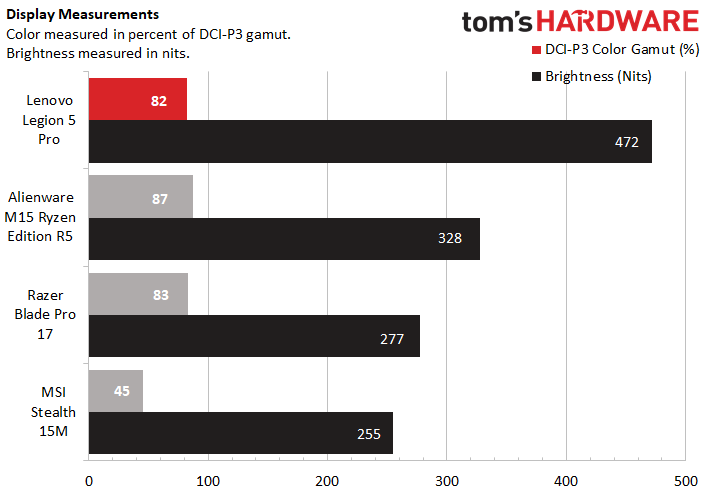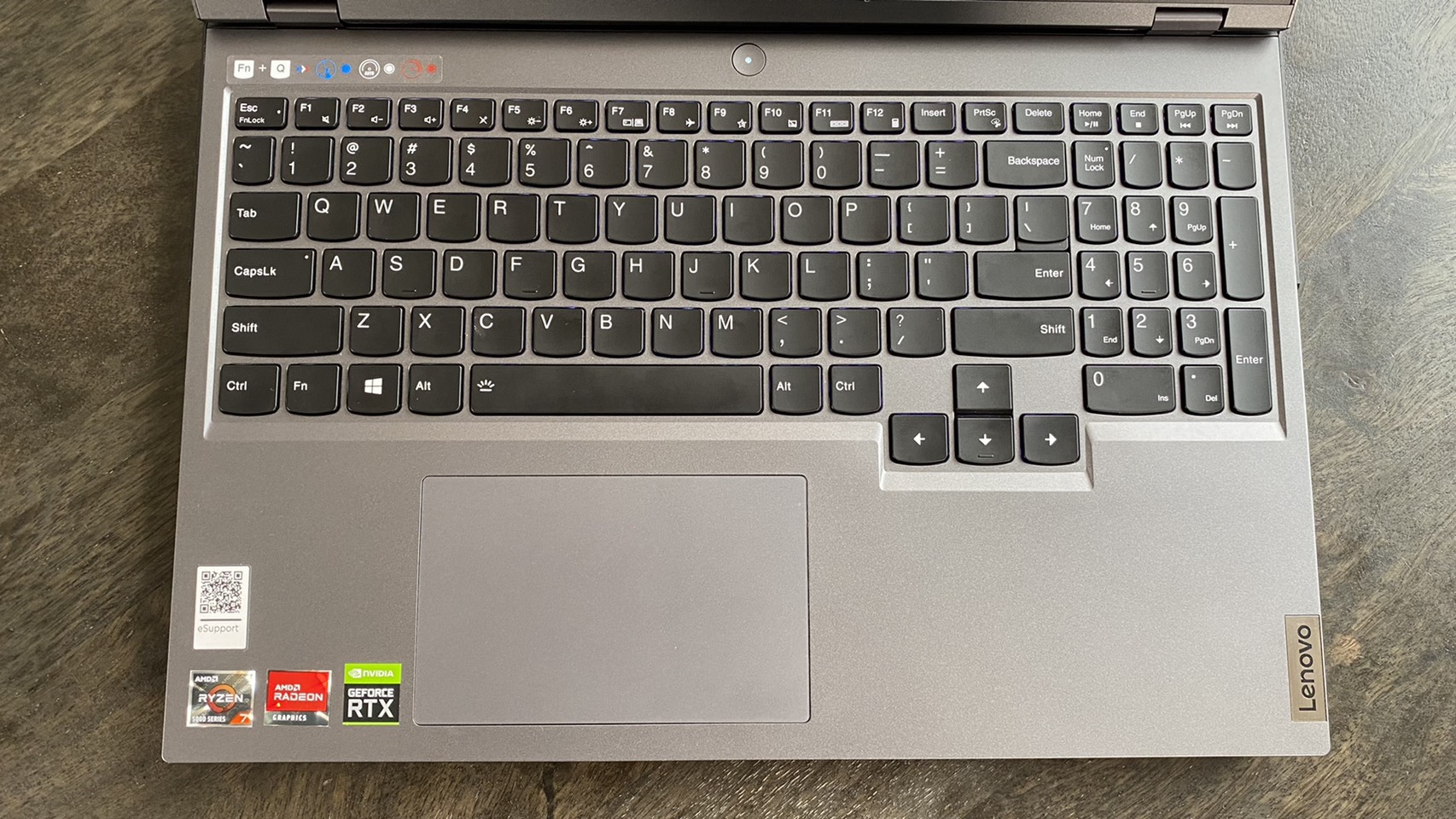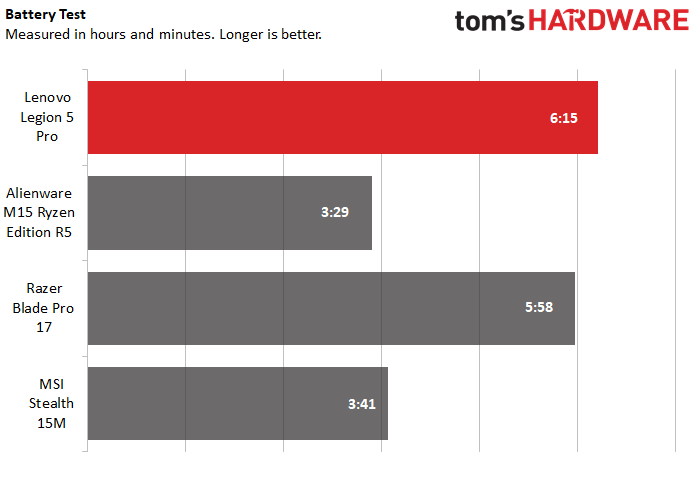Tom's Hardware Verdict
The Lenovo Legion Pro 5 performs just as well as other 45W AMD peers, but adds on to the experience with a screen that’s a delight to view and a keyboard that’s comfortable and easy to use.
Pros
- +
+ Strong performance
- +
+ Beautiful display
- +
+ Comfortable keyboard
Cons
- -
Bulky
- -
Middling audio
Why you can trust Tom's Hardware
The Legion 5 Pro is Lenovo’s latest contender in the high-end AMD gaming laptop world, sporting a 45W Ryzen 7 5800H CPU and a mobile Nvidia GeForce RTX 3070. To mark that occasion, Lenovo’s given the Legion 5 Pro a bit of a redesign over past models, fine-tuning the keyboard and display to help impress. This includes a new 16:10 aspect ratio and 2560 x 1600 resolution, which does move this laptop toward the expensive end of things ($1,899 as configured). That said, this is a device that feels premium and fun to use throughout, so you can argue that it earns that high price.
Lenovo Legion 5 Pro Specifications
| CPU | AMD Ryzen 7 5800H |
| Graphics | Nvidia GeForce RTX 3070 8GB GDDR6 with 140W TGP, 1,560 Mhz boost clock |
| Memory | 16GB DDR4-3200 |
| Storage | 512GB M.2 PCIe NVMe |
| Display | 16 inch, 2560 x 1600, 165Hz, IPS |
| Networking | Intel Wi-Fi 6 802.11ax, Bluetooth 5.1 |
| Ports | 4x USB 3.2 Gen 1 Type-A, |
| 2x USB 3.2 Gen 2 Type-C, | |
| 1x HDMI 2.1, | |
| 1x RJ-45 Ethernet, | |
| 1x 3.5mm combination headphone/microphone combo jack | |
| Camera | 720p |
| Battery | 80Wh |
| Power Adapter | 300W |
| Operating System | Windows 10 Home |
| Dimensions(WxDxH) | 14.02 x 10.41 x 1.07 inches (356 x 264.4 x 26.85 mm) |
| Weight | 5.4 pounds (2.45 kg) |
| Price (as configured) | $1,899.99 |
Lenovo Legion 5 Pro Design
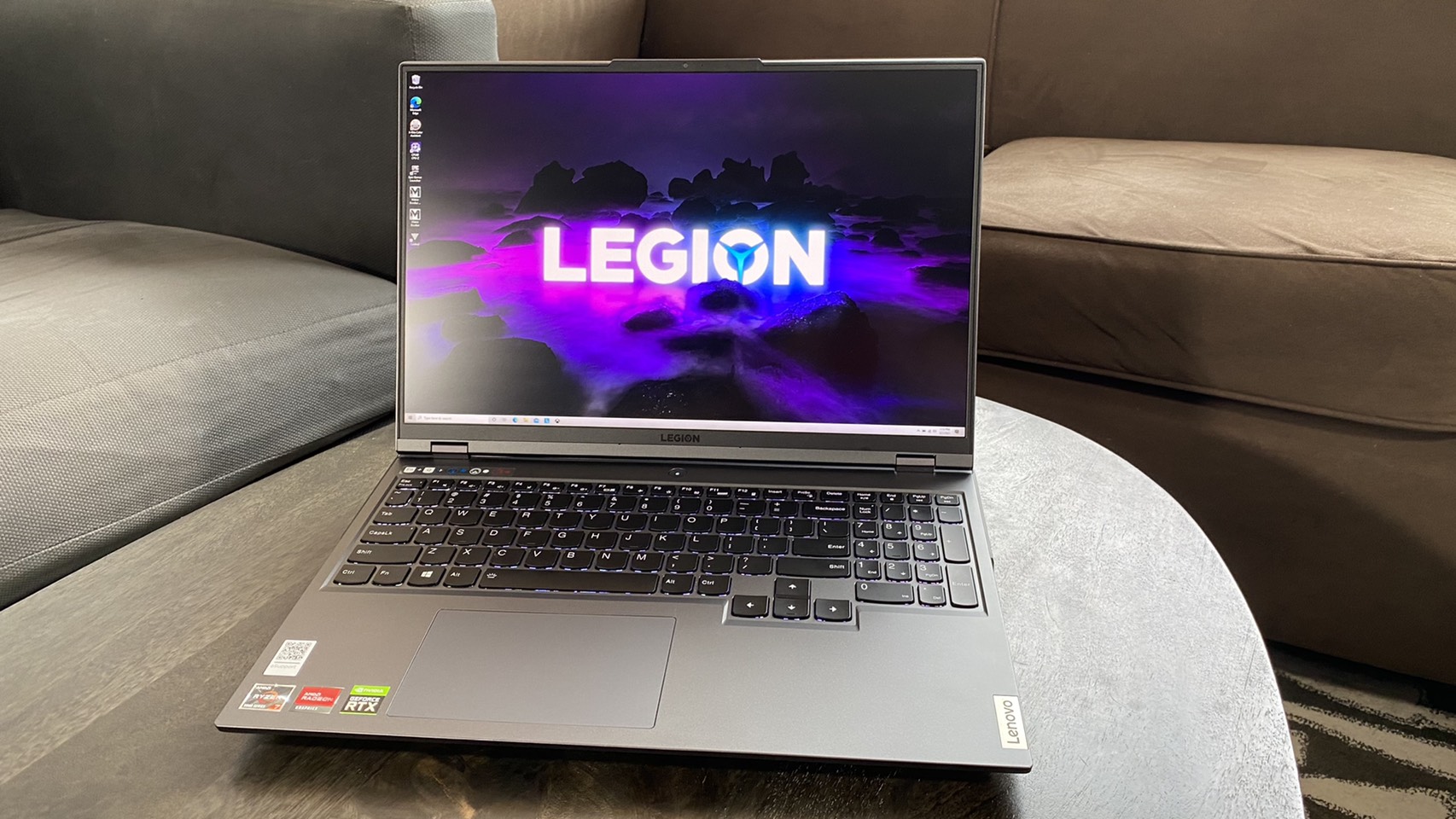
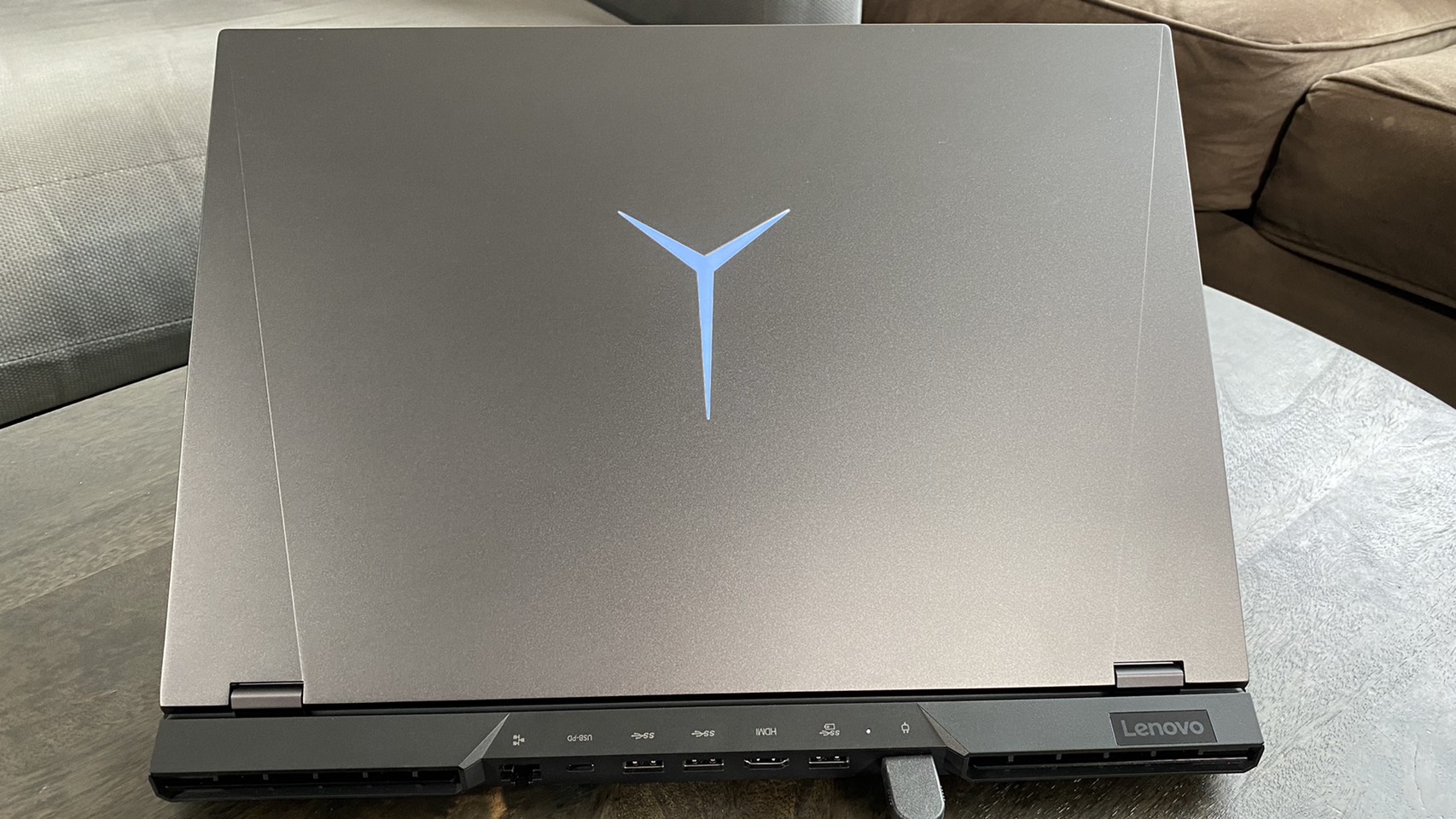

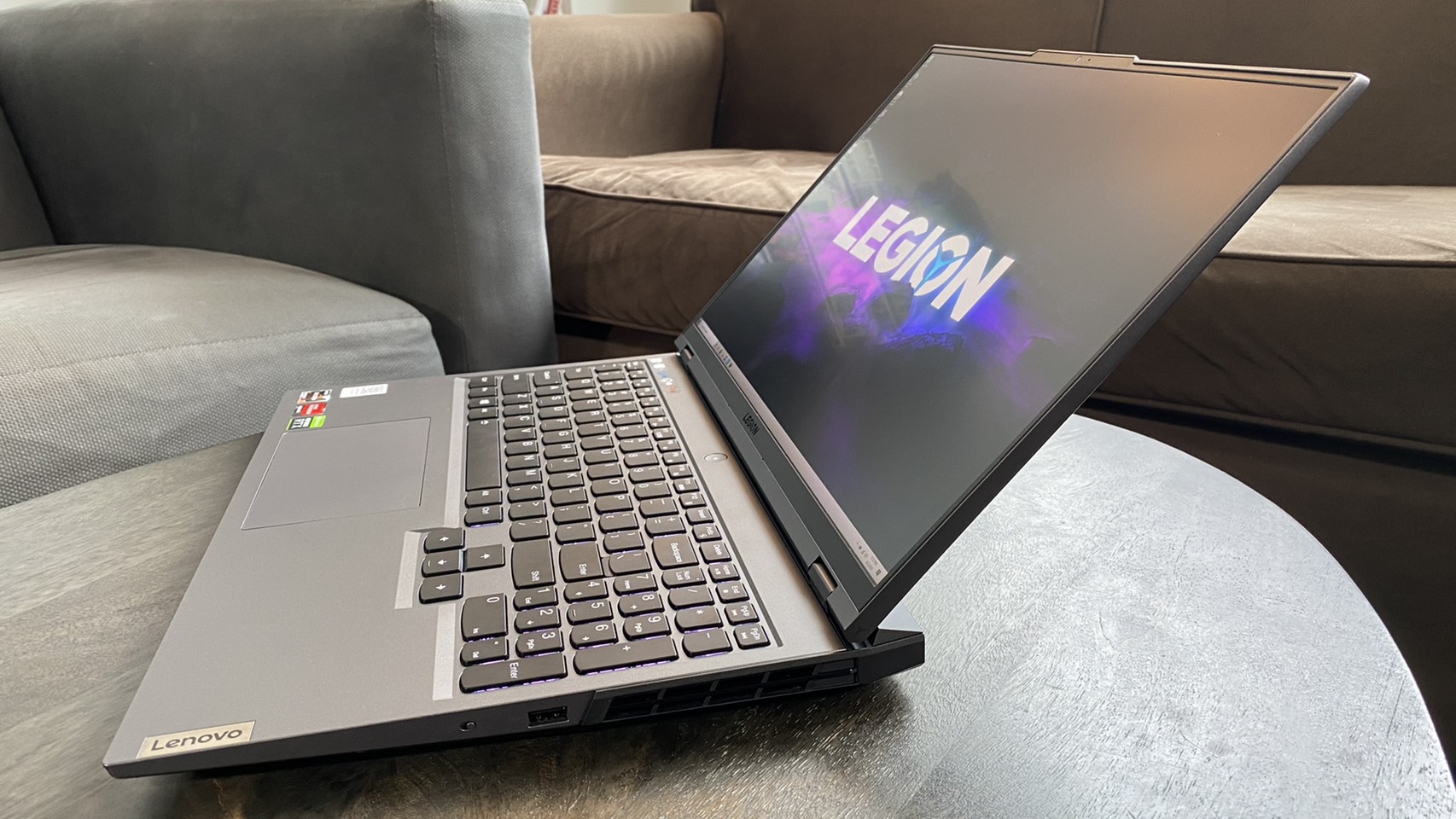
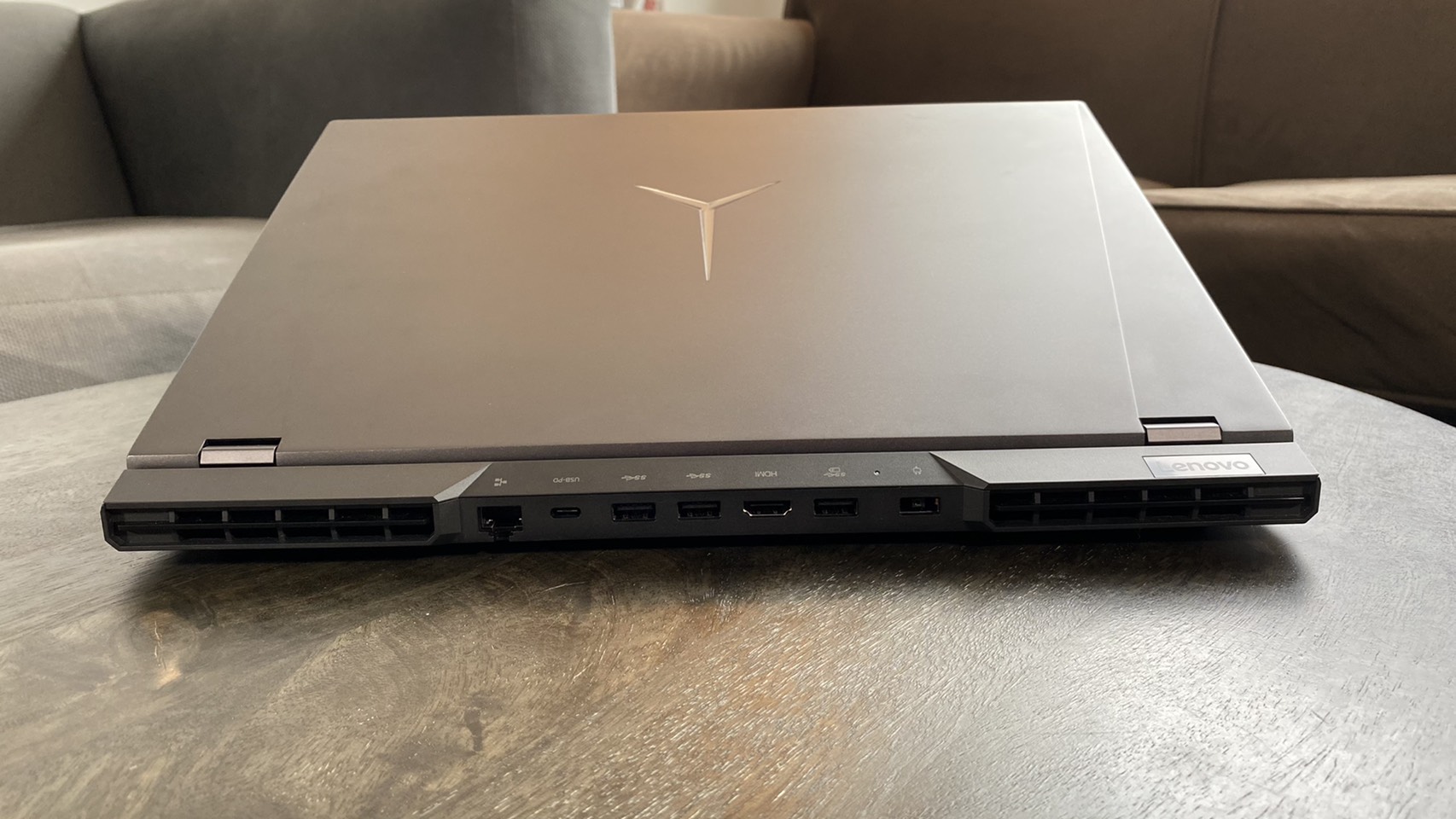
The Lenovo Legion 5 Pro looks in many ways identical to past Lenovo Legion models, with the key difference here being thinner bezels around the screen and a Y-shaped LED logo on the lid. Lenovo and Legion logos are still plentiful, from the keyboard deck to the hinge to the bottom screen bezel. The back of the hinge still extends far past the screen, with labeled I/O adorning the middle section. Large vents also sit along the laptop’s sides, back and underside.
The Legion 5 Pro also sticks with the Legion line’s usual grayish black color scheme, which works well to hide fingerprints. Also helping with fingerprints is the Legion 5 Pro’s glittery matte texture.
Despite having thinner bezels, this is a big laptop. At 14.02 x 10.41 x 1.07 inches, it’s much thicker than other RTX 3060 and RTX 3070 laptops we’ve tested. The Alienware M15 Ryzen Edition R5 is 14.02 x 10.73 x 0.9 inches, for instance. The Razer Blade Pro 17 is 15.6 x 10.2 x 0.8 inches, while the MSI Stealth 15M lives up to its name by almost halving the Legion 5 Pro’s thickness at 14.10 x 9.76 x 0.63 inches.
The Lenovo Legion 5 Pro is also a heavy laptop, weighing in at 5.4 pounds. It’s not alone here, though. The Alienware m15 Ryzen Edition R5 is 5.34 pounds, while the Razer Blade Pro 17 is even heavier than the Legion at 6.06 pounds. The MSI Stealth 15M once again lives up to its name here, though, weighing just 3.73 pounds.
With this heft comes plenty of space for ports, although most are relegated to the back of the laptop’s hinge. The Legion 5 Pro has a single USB 3.2 Gen 2 Type-C port on its left side, plus a 3.5mm combination headphone/microphone jack. The laptop’s right side has a USB 3.2 Gen 1 Type-A port and a hardware toggle that can turn power for the webcam on and off. The back of the laptop's hinge, meanwhile, is where you’ll find the charging port, plus three additional USB 3.2 Gen 1 Type-A ports and a single additional USB 3.2 Gen 2 Type-C port. That Type-C port also supports power delivery, though you’ll want to use the power brick when gaming. There’s an HDMI 2.1 connection and an RJ-45 ethernet port here, as well.
Lenovo Legion 5 Pro Gaming Performance
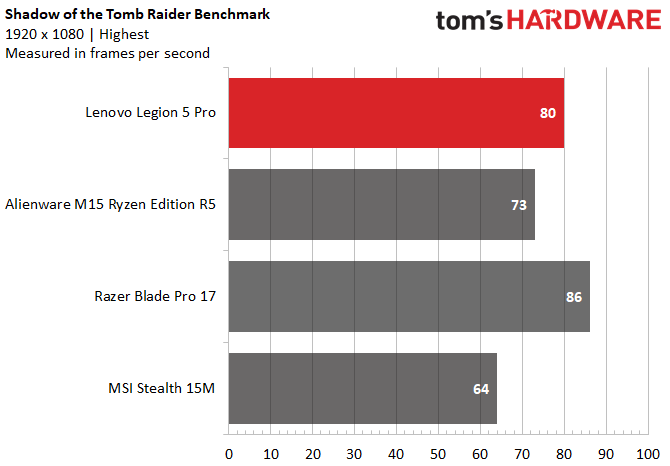
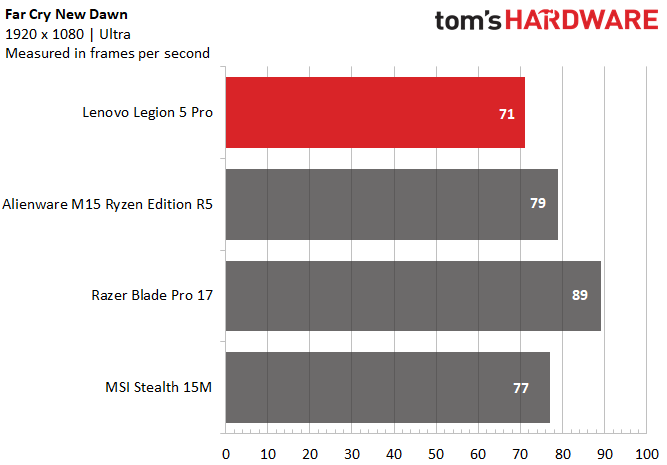
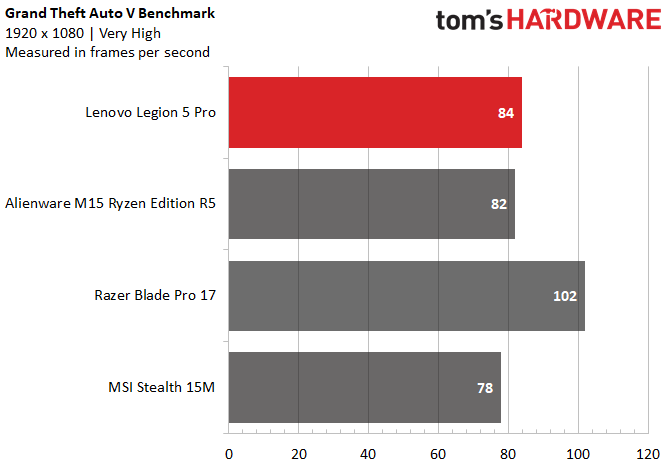

The Lenovo Legion 5 Pro has a AMD Ryzen 7 5800H CPU and an RTX 3070 laptop GPU with 8GB of GDDR6 memory and a 140W TGP. With its 16GB of DDR4-3200 memory, that puts it roughly on par with the Alienware m15 Ryzen Edition R5, which has the same CPU but has an RTX 3060 GPU. The Razer Blade Pro 17 is also a strong competitor here, thanks to its 10th gen, 45W Intel Core i7 CPU and RTX 3070 GPU. The MSI Stealth 15M is a capable thin competitor here, despite having a 35W 11th gen Intel Core i7, thanks to its RTX 3060.
Get Tom's Hardware's best news and in-depth reviews, straight to your inbox.
Generally, the Lenovo Legion 5 Pro tended to sit between second and third place in our gaming tests, usually behind the Razer Blade Pro 17 and alternating placements with the Alienware M15 Ryzen Edition R5.
In Shadow of the Tomb Raider’s built-in benchmark running on its highest settings at 1080p, the Lenovo Legion 5 Pro hit an average of 80 fps. That’s slightly below the Razer’s 86 fps but slightly above the Alienware’s 73 fps. The MSI lagged well behind at 64 fps.
The Legion 5 Pro didn’t perform as well in Far Cry: New Dawn’s benchmark running at 1080p with ultra settings. Here, its 71 fps fell well behind the Alienware’s 79 fps, and even further behind the Razer’s 89 fps. Even the MSI beat the Legion, with an fps of 77.
Grand Theft Auto V’s benchmark running on very high settings at 1080p saw the Legion 5 Pro’s performance jump back up. The Legion 5 Pro ran at 84 fps here, above the Alienware’s 82 fps and the MSI’s 78 fps. The Razer was far more impressive, though, achieving 102 fps.
Finally, Red Dead Redemption 2’s 1080p benchmark running at medium settings saw the Legion running at 66 fps, the Alienware hitting 53 fps, the Razer achieving 70 fps and the MSI bringing up the rear with 56 fps.
We also ran the Legion 5 Pro through our usual gaming stress test, to check how well it would perform in an extended heavy gaming session. Here, we ran the Metro: Exodus 1080p benchmark 15 times in a row using its RTX preset. The Legion averaged 65 fps throughout this run. Its CPU ran at an average 3.83 GHz, while its GPU hit an average 1.61 GHz. The CPU averaged a temperature of 83.48 degrees Celsius (182.26 degrees Fahrenheit) during this test, while the GPU was cooler, at 75.21 degrees Celsius (167.38 degrees Fahrenheit) average temperature.
I also played Control for a half-hour on the Legion 5 Pro, to get a personal feel for gaming on it. The Legion 5 Pro has a 2560 x 1600 screen, which makes anecdotal testing especially important as all of our benchmarks are run in FHD. On 2560 x 1600 on the high preset, the game generally ran between 75 - 85 fps. Dropping the resolution to FHD pushed that range up to 100 - 110 fps. When I turned ray tracing on and set it to its high preset, each resolution’s frame rate range dropped by around 20 frames.
The Legion 5 Pro was never hot to the touch while I played, although it was moderately loud.
Lenovo Legion 5 Pro Productivity Performance
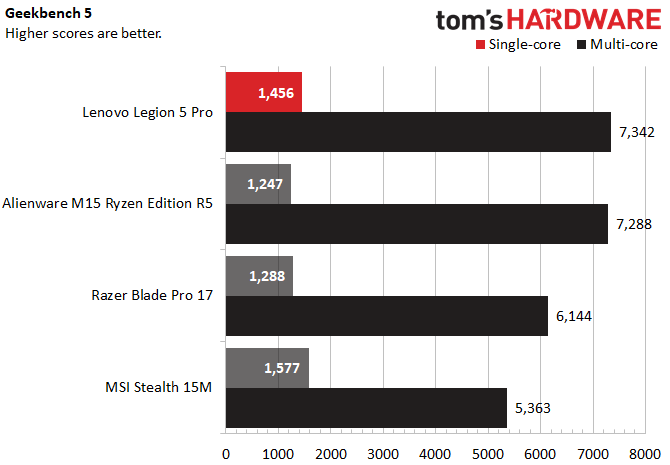
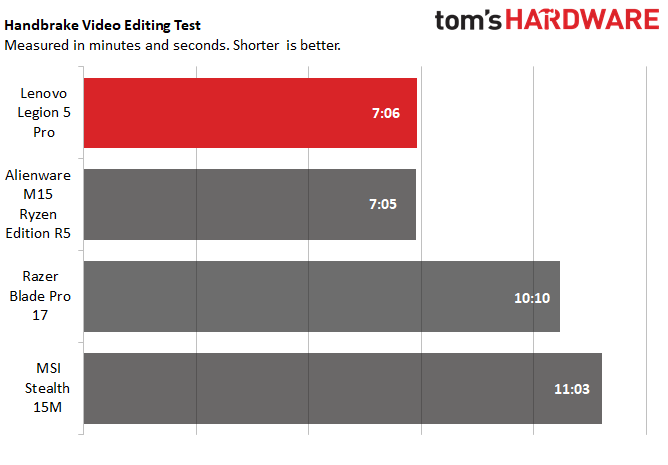

While the Lenovo Legion 5 Pro is a pretty big laptop to lug around for productivity work, its 45W AMD Ryzen 7 5800H CPU does make it a powerful work machine as well.
In Geekbench 5, which is a synthetic benchmark that tests general PC performance, the Legion 5 Pro generally outperformed its competition. It scored 1,456 on single-core tests and 7,342 on multi-core tests. That’s above the Alienware M15 Ryzen Edition R5’s 1,247/7,288 scores, which is impressive as that laptop shares the Legion’s CPU. It’s also above the Razer Blade Pro 17’s 1,288/6,144 scores, which makes sense as that laptop’s CPU is a generation behind (10th gen Intel), though it is 45W. The MSI Stealth 15M, which has a 35W 11th Gen Intel CPU, predictably performed much weaker than the Legion (at least on the multi-core test) with scores of 1,577/5,363.
The Lenovo Legion 5 Pro and the Alienware M15 Ryzen Edition R5 both had similar scores in our file transfer test, where we track how quickly a machine can move 25GB of files. The former did so with an 832.66 MBps speed, while the latter was slightly faster with an 874.14 MBps speed. The MSI Stealth 15M was the next fastest, with a speed of 651.85 MBps, and the Razer Blade Pro 17 was the slowest laptop we tested, with a speed of 547.2 MBps.
The Legion 5 Pro and the Alienware M15 Ryzen Edition R5 had near-identical scores in our Handbrake video transcoding test, where we time machines to see how quickly they transcode a video down from 4K to FHD. The Legion finished transcoding in 7:06, while the Alienware was literally just a second faster (7:05). The Razer Blade Pro 17 was the next fastest with a 10:10 time, and the MSI Stealth 15M was the slowest of the bunch with a time of 11:03.
Lenovo Legion 5 Pro Display
The Lenovo Legion 5 Pro joins in on the 16:10 trend with a 2560 x 1600 IPS monitor that has a 165Hz refresh rate. I used this monitor to watch the final trailer for A Quiet Place II, which had impressively deep blacks and somewhat vivid colors. Even with my curtains up and my lights on, viewing angles were essentially perfect, and glare was almost a non-issue. Lowering my curtains and turning my lights off eliminated glare entirely.
Those impressive viewing angles and the lack of glare can probably be attributed to the display’s high brightness. In our testing, we found that it hit an average of 472 nits, which far exceeds the Alienware M15 Ryzen Edition R5’s 328 nits. The Razer Blade Pro 17 and MSI Stealth 15M were even dimmer at 277 and 255 nits, respectively.
Color was more evenly distributed across competitors, with the Legion 5 Pro achieving an 82% DCI-P3 rating. The Alienware was slightly more colorful with an 87.3 DCI-P3 rating, while the Razer’s 83.9% rating was roughly on par with the Legion’s. The MSI Stealth 15M was much less colorful, with only a 45.3% DCI-P3 rating.
Since the Legion 5 Pro has a 16:10 screen, I would also be remiss if I didn’t mention web browsing on it. I really appreciated the extra screen space when typing emails and reading articles, which worked especially well with the higher-than-1080p resolution. Plus, the laptop’s large trackpad made navigating that extra screen space easy.
Lenovo Legion 5 Pro Keyboard and Touchpad
The Lenovo Legion 5 Pro has a “TrueStrike Gaming Keyboard,” which features 100% anti-ghosting, 4-zone RGB and a full tenkey (though the latter is a bit squished). Lenovo also promises “excellent key travel,” although it hasn’t provided numbers to us.
In my experience, using the TrueStrike keyboard was equivalent to using one of Lenovo’s ThinkPad keyboards, which is to say that it was exceedingly comfortable and responsive. Like ThinkPads, the Lenovo 5 Pro’s keycaps are curved at the bottom and concave in the center, which makes typing by touch alone a breeze. I felt like I had plenty of tactile feedback and the key travel did seem generous, so I was easily able to hit the upper end of my 75 - 80 words per minute average on 10fastfingers.com’s typing tests.
The Legion 5 Pro’s precision touchpad is a generous 4.7 x 3 inches large. Its smooth surface made both moving my cursor and inputting two- and three-finger multi-touch gestures like scrolling and switching apps a breeze. It does sit slightly off-center, although I found that its palm rejection was effective enough that I was able to play WASD shooters while my palm touched the touchpad without it affecting mouse input. You can also toggle touchpad input on and off both in Lenovo Vantage and with an Fn row keyboard shortcut.
Lenovo Legion 5 Pro Audio
The Lenovo Legion 5 Pro has two bottom-firing speakers, one on either side, that get effectively loud but can run on the tinny side. I tested these speakers out by listening to “Astronaut in the Ocean” on them, which might not have been the best choice for this laptop. That’s because I pretty quickly reached the floor for how much bass this laptop could put out, which cut off much of the song’s impact.
That said, the Legion 5 Pro’s speakers do well with small details. The lo-fi, radio-like pops and buzzes at the start of the song came across well on the Legion, and the bass guitar-like string quality that some of the bass line has also wasn’t lost here.
The Lenovo Legion 5 Pro also comes with Nahimic audio software that uses an equalizer to fine-tune your audio. I tested the speakers using the music preset, but there’s also a movie preset that prioritizes both vocals and sound effects, as well as a communications preset that focuses purely on talking and a gaming preset that caters mostly to sound effects. Naturally, I found the song was at its best using the music preset.
Lenovo Legion 5 Pro Upgradeability
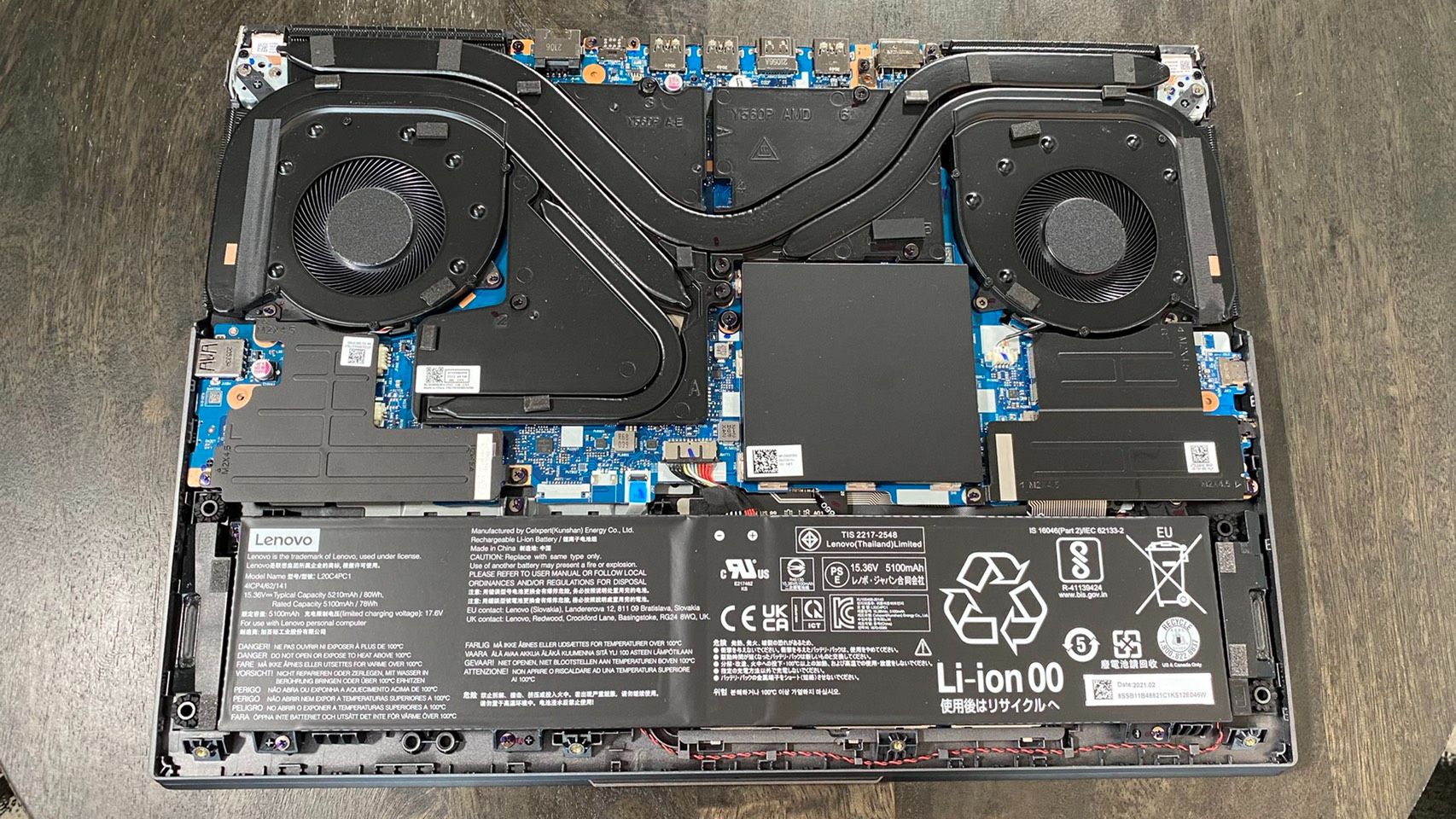
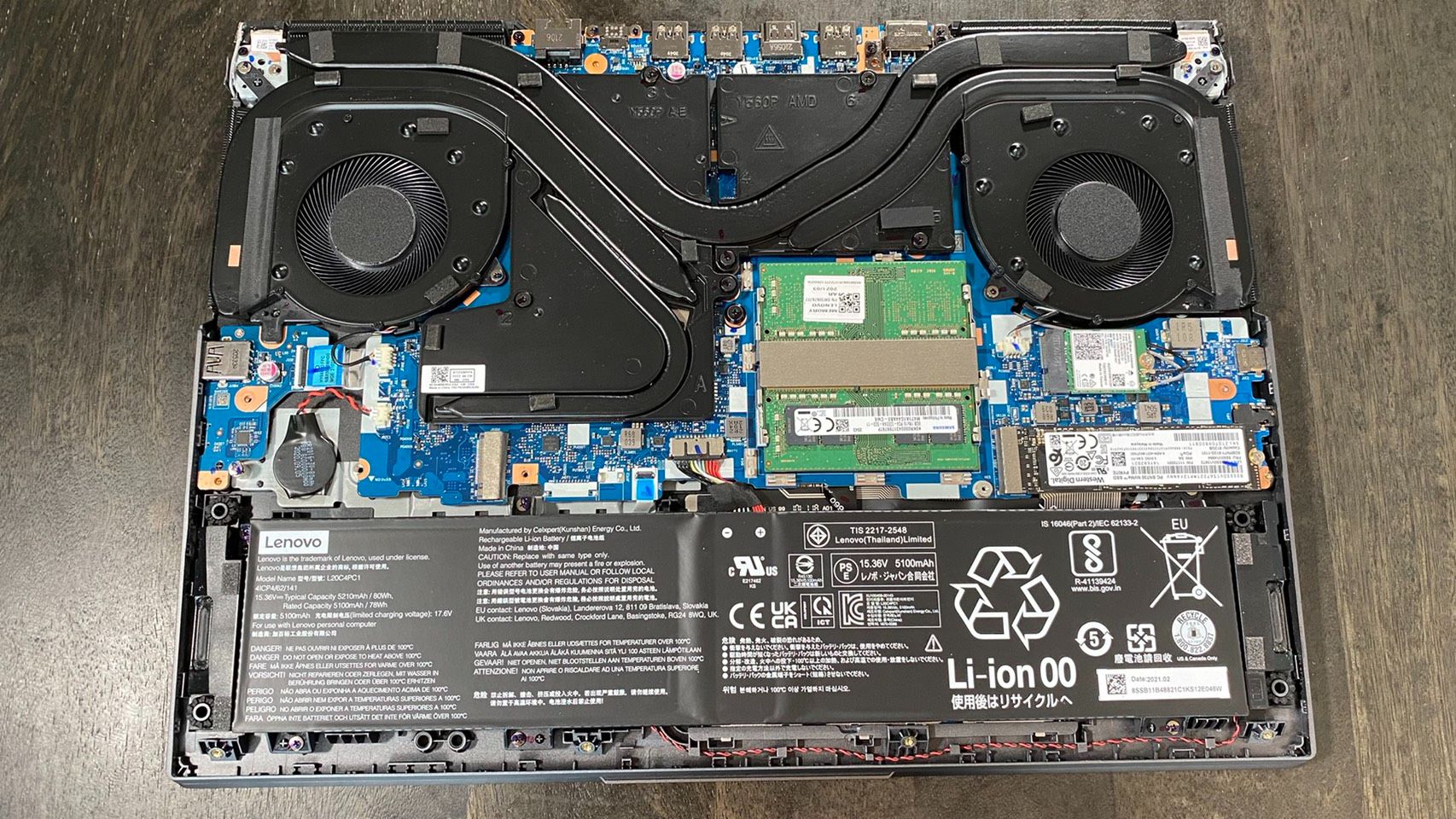
One benefit to the Lenovo Legion 5 Pro’s size is that it’s plenty upgradeable. Just remove the 10 screws on the underside with a Phillips head screwdriver (we used a PH00 screw bit) and gently remove the bottom of the chassis. Getting the bottom off might take some finagling since the side vents are attached to it, but just keep at it and it will come off eventually.
Once inside, you’ll see one SSD shield on either side of the laptop and a RAM shield in its center. You can remove the RAM shield by gently lifting it up with your fingertips, but the SSD shields are connected with 3 Phillips head screws each (we also used a PH00 screw bit here).
Once everything is off, you’ll be able to replace either side’s SSD (or add a new one if your configuration only came with one SSD) as well as both SO-DIMMs of RAM. You’ll also have access to the networking card.
Lenovo Legion 5 Pro Battery Life
Whether it’s due to the larger size giving it room for a bigger battery or just greater efficiency in the general design, the Lenovo Legion 5 Pro has a long battery life for a gaming laptop. In our non-gaming battery life benchmark, which continually streams video, browses the web and runs OpenGL tests over Wi-Fi at 150 nits of brightness, the Legion 5 Pro held on for 6 hours and 15 minutes.
That’s a little longer than the Razer Blade Pro 17’s 5:58, but almost double the Alienware M15 Ryzen Edition R5’s 3:29 and the MSI Stealth 15M’s 3:41.
Lenovo Legion 5 Pro Heat
The Lenovo Legion 5 Pro never felt hot or even overly warm to the touch during our time with it, but it could get toasty under the hood during select tests. To examine both non-gaming and gaming performance, we took the laptop’s temperature both after 15 minutes of streaming video and during the sixth consecutive run of the Metro: Exodus extreme benchmark.
In our streaming video test, the Legion 5 Pro registered 78.6 degrees Fahrenheit on the touchpad, 93.6 degrees Fahrenheit in the center of the keyboard (between the G/H keys) and 91.9 degrees Fahrenheit across most of its underside. The hottest part of the laptop was in the middle of the underside vents, where it reached 102.6 degrees Fahrenheit.
In our Metro test, the touchpad actually fell in temperature to 73.9 degrees Fahrenheit, but the laptop got hotter everywhere else. The center of the keyboard was now 102.4 degrees Fahrenheit, while the general underside was 100 degrees Fahrenheit. That hot point in the middle of the underside vents jumped all the way up to 132.1 degrees Fahrenheit, however.
Lenovo Legion 5 Pro Webcam
The Lenovo Legion 5 Pro comes with a 720p webcam that has surprisingly strong quality under ideal lighting conditions, but becomes drastically worse in low or heavy light.
Sitting on my desk during mid-day with my curtains up, I was easily able to make out plenty of details on my face, plus all the individual strands poking out from my quarantine-stricken hairdo. Colors were accurate, and I’d be confident calling in to a video conference with this camera under these conditions.
Unfortunately, when I moved the laptop to my much dimmer hallway, the quality fell along with the light. My face and hair suddenly became blurry and pixelated, and I feel like it would be unprofessional to call into a video conference with this level of quality.
Under saturated light, with the webcam pointing directly out my office window, the picture’s quality jumped back up, but its color didn’t adjust well. Everything was bathed in a cool, blue tone that made me look vaguely underwater. So, while you can make out my facial details well here, the only event I’d call into like this would be a virtual under-the-sea dance.
The Lenovo Legion 5 Pro also comes with a switch on its right side that turns power to the webcam on and off. This is here instead of a physical shutter over the webcam, which couldn’t fit in the laptop’s thin bezels.
Lenovo Legion 5 Pro Software and Warranty
Like most of Lenovo’s laptops, the Lenovo Legion 5 Pro doesn’t have much in the way of bloatware, instead offering an array of genuinely useful utility programs.
Lenovo Vantage is where you’ll probably spend most of your tinkering time. You’ll set up your keyboard lighting from here, plus toggle different battery saving and performance options on and off as well as monitor your CPU and SSD usage. Vantage is also where you’ll update your PC’s BIOS, set up macro keys and more.
Lenovo Utility is far simpler, and simply displays icons on your screen whenever you use a keyboard shortcut — for example, turning off the touchpad.
The Nahimic Audio Console is here too, and comes with an equalizer to fine tune what your speakers sound like, plus movie, music, video call and gaming presets if you don’t want to mess with it in detail. Dolby Vision is also present, and lets you quickly toggle your screen to prioritize brightness, vivid colors or even a dim look.
In a puzzling move, our review unit also came installed with AMD Radeon Software, even though this laptop uses an Nvidia GPU. As such, it does nothing when you click on it.
Finally, the Lenovo Legion 5 Pro also has typical Windows pack-ins like Microsoft Solitaire Collection and Spotify.
This laptop comes with a 1-year limited warranty.
Lenovo Legion 5 Pro Configurations
Our review unit for this laptop came with an AMD Ryzen 7 5800H CPU, an RTX 3070 8GB GDDR6 laptop GPU with a 140W TGP, 16GB of DDR4 RAM running at 3200 MHz, 512GB of M.2 PCIe NVMe storage and a 16 inch 2560 x 1600 IPS display with a 165Hz refresh rate.
Lenovo currently only has one model of the Lenovo Legion 5 Pro up on its website, and it’s listed for $1,959 and currently isn’t available to purchase. This model mirrors our review unit, but has 2TB of storage as opposed to our unit’s 512GB. When we started writing this review, there was a model matching our review unit on the Lenovo website being sold for $1,899, but it no longer appears to be listed. This may have something to do with issues stocking machines due to component shortages.
Bottom Line
When it comes to performance, the Lenovo Legion 5 Pro is right up there with most competitors, but it really sells itself with its strong keyboard and display combo. This laptop is on the more expensive end, selling for upwards of $1,800 depending on your configuration (if you can find it in stock), but that money will buy you an exceptionally comfortable ThinkPad-style keyboard and a 16:10 screen with a slightly higher than 1440p resolution.
So, if all you want is high performance, you might do better with competitors like the Alienware m15 Ryzen Edition R5, which almost mirrors the Legion 5 Pro in specs but is cheaper thanks to a lower-resolution 1080p screen. But if you want a laptop that feels premium all around, the Legion 5 Pro earns its price tag, while still coming in cheaper than extremely high-end options like the $2,560 Razer Blade Pro 17.
Michelle Ehrhardt is an editor at Tom's Hardware. She's been following tech since her family got a Gateway running Windows 95, and is now on her third custom-built system. Her work has been published in publications like Paste, The Atlantic, and Kill Screen, just to name a few. She also holds a master's degree in game design from NYU.
-
reader012345678901 I did not expect a Laptop with a RTX 3070 mobil 140W to perform so poorly in the gaming benchmarks. The Razer 17 has a 100W GPU, the Alienware m15 has a RTX3060 with 120W, the MSI 15M has just a 3060 with 65 W.... Why dosen't this laptop easily outperform those competitors?Reply
(Sure, the Razer 17 is bigger, but has only a 10th Gen CPU & a significant lower GPU TGP, and the legion is definitly not one of these ultra portable gaming laptops either)
Good looking Display sounds great though. -
watzupken I think the specs is incorrect, "The Lenovo Legion 5 Pro joins in on the 16:10 trend with a 2560 x 1440 IPS monitor that has a 165Hz refresh rate. "Reply
This should be the correct specs taken from Lenovo's website,
16.0"2.5K, IPS, Anti-Glare, LED Backlight, Narrow Bezel, HDR, 100%sRGB, Non-Touch, 165Hz 2560x1600 -
watzupken Reply
If you look for reviews of this laptop online, you will find answers to your question. In summary, there are 4 things that will hamper performance for this laptop, and potentially other Ryzen based laptops out in the market,reader012345678901 said:I did not expect a Laptop with a RTX 3070 mobil 140W to perform so poorly in the gaming benchmarks. The Razer 17 has a 100W GPU, the Alienware m15 has a RTX3060 with 120W, the MSI 15M has just a 3060 with 65 W.... Why dosen't this laptop easily outperform those competitors?
(Sure, the Razer 17 is bigger, but has only a 10th Gen CPU & a significant lower GPU TGP, and the legion is definitly not one of these ultra portable gaming laptops either)
Good looking Display sounds great though.
1. RAM with slower timings used - Despite being DDR4 3200 CL22, Crucial have increase the timings of newer RAMs very significantly. As Ryzen chips are more sensitive to RAM timings, it drops performance quite significantly to the tune of around 10% on average,
2. Corsair iCUE software - When this is enabled, this takes a lot of CPU processing power, which deprives the system of CPU power when it needs it for gaming
3. Testing resolution - Ampere is more susceptible to being CPU bound, especially at lower resolution. At 1080p and the games selected, it just doesn't allow the GPU to stretch its legs. Switching over to 1440p or 1600p, that will take the bottleneck off the CPU and will result in a the 3070 performing quite a fair bit faster than the RTX 3060 mobile
4. To get the most out of the laptop, the laptop needs to run at performance mode. At balance or lower, it nerfs the CPU and GPU quite a fair bit. -
pixelpusher220 Ports on the back just seem like asking for broken ports.Reply
Given the expanding number of laptops with this design, has anyone seen this?
For desktop replacement usage, perhaps, but any use in the actual portable sense seems like these would be problematic -
watzupken Reply
Generally when you are on the go, the USB port on each side of the laptop is enough to allow a mouse and another device like portable hard disk/ mobile phone to be connected. So I feel that pretty much addresses most people's need on a laptop, when you are on the go/ portable. For me, the ports at the rear make sense given that this laptop is not exactly mobile when you have to lug a 1+ KG power brick along. And I actually prefer display out ports to be located at the rear because it gets very unsightly on either the left or right of the laptop, and may potentially cause some obstructions. From other reviews I saw for this laptop, there are LED lit logos telling you what ports are at the back. So that also helps without you physically having to turn the laptop around to find the port you want to use.pixelpusher220 said:Ports on the back just seem like asking for broken ports.
Given the expanding number of laptops with this design, has anyone seen this?
For desktop replacement usage, perhaps, but any use in the actual portable sense seems like these would be problematic -
suedezu I have this laptop for more than 2 weeks and it's amazing for gaming and productivity tasks alike.Reply
I have the Ryzen 5800H, 3700, 32GB RAM, 2 TB SSD config and It runs every game I've tried smoothly and at very high or max settings. I've played Dirt 5, Red Dead Redemption, Metro Exodus Enhanced Edition, Wolfenstein: Youngblood. All these games were at the 1600p native resolution with RayTracing and DLSS where available.
RAM is holding you back only if you're CPU bound (playing at 1080p) and only on the 16 GB configs. Playing at 1600p, the incurred penalty for not having the fastest possible RAM modules is between 3-5%. To my eyes, it's pretty negligible and not worth the hassle of buying more expensive RAM and having to resell the current kit.
The location of the ports at the back is really clever and useful as it allows hiding all the messy cables behing the screen. Besides on each side there is a USB type C and type A port and the combo headphone/mic port so you're pretty much set should you wish to use a USB dongle/stick.
Someone mentioned Corsair ICU software on this laptop and it's wrong. ONLY the Legion 7 has this software as it has RGB galore. The Legion 5 Pro has a simpler 4-zone RGB keyboard so Corsair ICU would not work on the Legion 5 Pro.
One more thing: the display on this laptop is AMAZING! Bright, accurate, matte finish, fast refresh. It's a dream display!
If you want more info on this laptop from actual owners check this Discord channel dedicated to the Legion 5 Pro https://discord.gg/hGt9hGKb -
JWNoctis The slight graphic performance loss -might- also be partially accountable to the PCIe bus, which is limited to 3.0 x8 for the discrete chip on this machine. At least on mine.Reply
No idea if that's normal. EDIT: For the record, it is. Cezanne platform limit.
Disabling the integrated GPU via BIOS settings also made some slight difference, on the scale of <5% improvement in terms of 3Dmark11 score.
But yes, it's great - Much better than any desktop machine I could get the parts for in these times for the same price.
